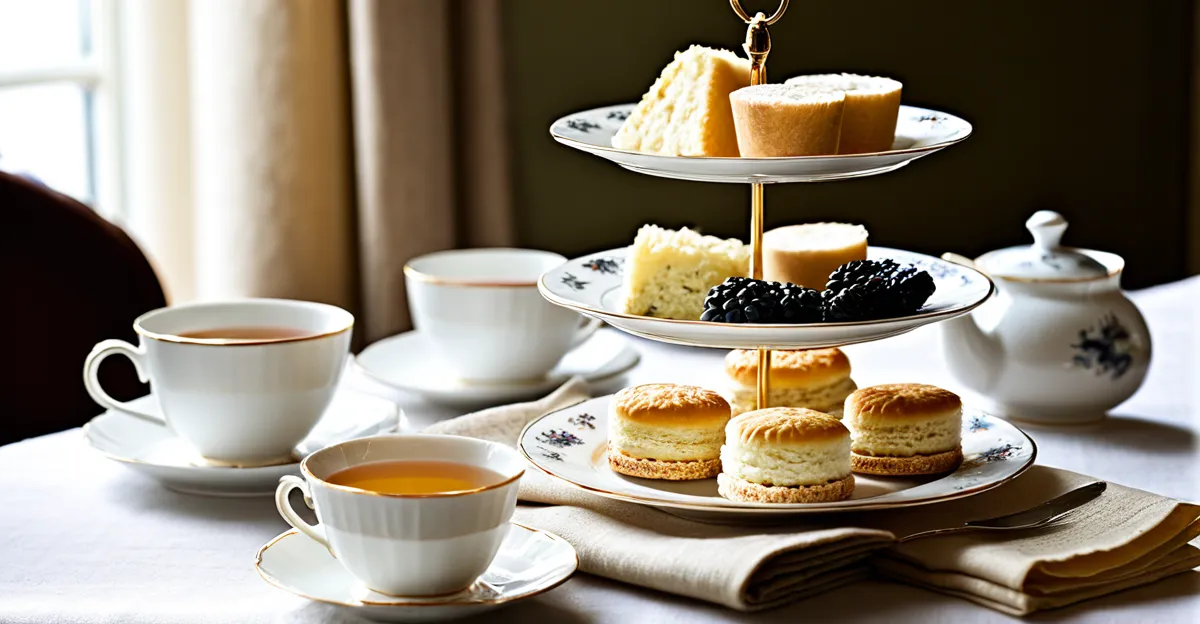Essential Elements of a Traditional English Afternoon Tea
A traditional afternoon tea centers on a harmonious balance of flavors and presentation. The core afternoon tea components include a carefully chosen tea selection, a variety of delicate finger sandwiches, freshly baked scones, and an assortment of pastries. Each element plays a crucial role in delivering the authentic experience of tea time essentials.
Tea selection provides the foundation—typically black teas like Earl Grey or Assam are preferred. Sandwiches follow, often with classic fillings like cucumber or egg mayonnaise, cut into neat rectangles or triangles to encourage elegant nibbling. Scones, either plain or with fruit, are served warm alongside clotted cream and jam, representing the quintessential authentic English tea accompaniment. Finally, a selection of pastries or small cakes adds a sweet finish.
Additional reading : What are the secrets to making authentic British scones?
Key equipment enhances the experience: a three-tiered cake stand displays sandwiches, scones, and pastries with grace. Fine bone china teacups, silver cutlery, and linen napkins complete the table setting. The table is arranged thoughtfully, often with flowers and polished silverware to evoke the charm and refinement expected at an English afternoon tea.
This presentation not only respects tradition but also elevates teatime into a memorable social ritual.
In the same genre : How do you achieve the perfect texture in a homemade Lancashire hotpot?
Selecting the Best Teas for Your Afternoon Tea
Choosing the right teas is fundamental to a traditional afternoon tea. Popular English teas like Earl Grey, Darjeeling, and Assam each offer distinct flavors suited to different palates. Earl Grey is prized for its citrus notes, Darjeeling delights with delicate floral tones, and Assam provides a robust, malty base ideal for cream and sugar.
For the best experience, use loose leaf tea, as it retains more essential oils and flavors compared to tea bags. Brewing time typically ranges from 3 to 5 minutes at near-boiling water, depending on the tea type. Oversteeping can cause bitterness, so precision is key.
When serving, offer milk, lemon slices, and sweeteners separately. This respects individual preferences, a hallmark of tea time essentials. Milk is traditionally added to stronger black teas like Assam, while lemon pairs well with lighter varieties such as Darjeeling.
Proper tea preparation elevates the whole afternoon tea components experience. It shows respect for the authentic English tea tradition, bringing out complex flavors that guests will appreciate. Mastering these basics ensures tea complements sandwiches, scones, and pastries perfectly.
Preparing Classic Afternoon Tea Sandwiches
Afternoon tea sandwiches are a cornerstone of the traditional afternoon tea, lending variety and subtle flavours that complement the tea itself. Typical afternoon tea sandwiches feature delicate, crustless breads filled with classic options such as cucumber, egg mayonnaise, and smoked salmon. These fillings balance freshness, creaminess, and a touch of luxury, all vital to tea time essentials.
Successful tea sandwich tips include slicing ingredients finely and using soft, fresh bread to maintain a tender bite. Cut sandwiches neatly into small triangles or rectangles to encourage dainty nibbling, preserving the elegant atmosphere of an authentic English tea.
For practical hosting, sandwiches can be prepared several hours ahead and stored lightly covered in the refrigerator. This keeps them fresh without drying out. When assembling, slightly buttering bread can create a moisture barrier, prolonging sandwich quality until served.
By mastering traditional fillings and simple preparation techniques, sandwiches at your traditional afternoon tea will offer both pleasure and authenticity. Their role is essential: providing savoury balance before the sweetness of scones and pastries unfolds.
Baking Scones and Accompaniments
Mastering scone recipes is vital for an authentic traditional afternoon tea. Start with basic ingredients: flour, baking powder, butter, sugar, milk, and eggs, gently combined to keep the dough light. For fruit scones, add currants or raisins sparingly to maintain texture without weighing down the dough. Handling the dough minimally prevents toughness, ensuring the ideal crumbly and tender consistency prized in tea time essentials.
Bake scones in a hot oven, around 220°C (425°F), for 12–15 minutes until golden. This high temperature encourages a perfect rise and a lightly crisp exterior, crucial for an authentic English tea experience. Serve freshly baked scones warm, as chilling can dry them out and diminish quality.
Scones are traditionally accompanied by clotted cream and jam. The classic pairing balances creamy richness with fruity sweetness, essential to the scone’s role in afternoon tea components. When spreading, a debated order arises: whether cream or jam goes on first depends on regional preference, but either method showcases the scone’s versatility at traditional afternoon tea.
Attention to baking precision and quality accompaniments elevates scones from simple bread to an essential centerpiece of authentic English tea.
Creating Elegant Pastries and Cakes
An authentic traditional afternoon tea is incomplete without a selection of exquisite afternoon tea pastries. British classics like the Victoria sponge cake and Battenberg bring charm and sweetness to the table. These cakes, usually cut into dainty portions, offer delicate textures and satisfy the craving for sweet treats at the close of an afternoon tea components lineup.
In addition to these staples, consider mini cakes or petit fours that incorporate fresh fruits, creams, or light icings. These bite-sized delights maintain the refined atmosphere of an authentic English tea, allowing guests to sample a variety of flavors without overwhelming the palate.
Presentation is crucial: elegant pastries are best served on a tiered cake stand, complementing the sandwiches and scones and reinforcing the quintessential tea time essentials aesthetic. Whether homemade or carefully selected store-bought items, pastries should be visually appealing and varied in taste and texture.
Balancing richness with subtlety, these cakes and sweet treats complete the traditional afternoon tea experience, delighting guests and showcasing the artistry involved in this beloved British custom.

